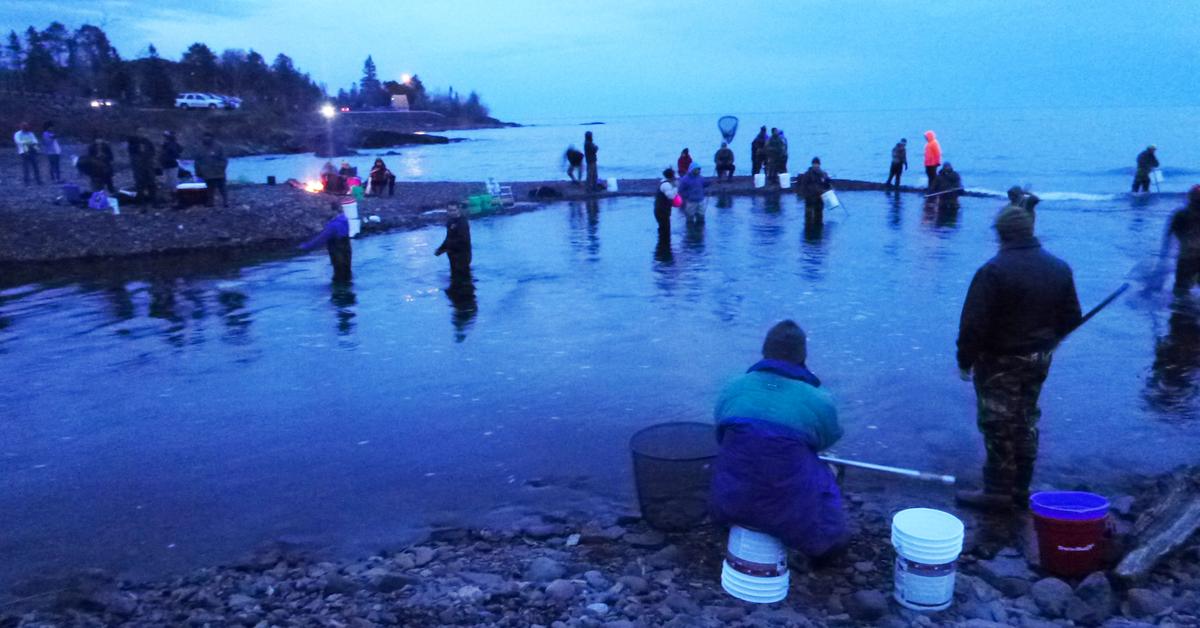As spring finally arrives in fits and starts to Minnesota’s North Shore a dedicated group of fishers armed with dip nets and seines eagerly watch the river flows and water temperatures in anticipation of Lake Superior’s annual Rainbow Smelt run.
Most fish prognosticators are predicting at least a two-week delay in this year’s Smelt run due to the late winter thaw and the cool temperatures forecast over the remaining weeks of April and early May.
A good rule of thumb is that when river temperatures are between 40 F and 44 F the Rainbow Smelt begin their spawning run from Lake Superior. An up-to-date source of information on North Shore stream temperatures and the status of the Rainbow Smelt run is the Minnesota Department of Natural Resources Lake Superior weekly fishing report.
A Minnesota DNR fact sheet on Lake Superior Rainbow Smelt provides general information on how to catch Smelt and a reference of important regulations that apply to Smelt fishing.
So, while Minnesota Sea Grant wants you to enjoy your Smelt fishing adventures this spring, we want you to be aware of the consumption advisories too.
The Minnesota Department of Health’s Lake Superior Rainbow Smelt consumption advisory remains the same as the advice issued in 2021, according to MDH Environmental Surveillance and Assessment Manager James Kelly. The big reduction in recommended consumption limits is due to the presence of a chemical once used in water and stain repellent products, called PFOS or perfluorooctane sulfonic acid.
MDH’s current advice for consumption of Lake Superior Rainbow Smelt is one (1) meal per month based on levels of PFOS found in fish samples. The department’s 2021 advisory was issued due to the high levels of PFOS found in Lake Superior Rainbow Smelt samples taken by the Wisconsin Department of Natural Resources in 2020.
“More data are needed to better understand the extent of PFOS contamination in Smelt and other Lake Superior fish, and we’re working to collect those data,” Kelly said. “In the meantime, to protect public health we continue to recommend these limits on fish consumption.”
Once a key component of Scotchguard and other water and stain repellents, PFOS is showing up in Lake Superior Smelt. PFOS is linked to human illnesses and health issues including fertility, cancer, hormonal and immunity and developmental problems. PFOS is one of a group of related chemicals known as perfluorinated alkylated substances (PFAS), which do not occur naturally. Some PFAS do not break down easily in the environment and can stay in a person’s body for a long time.
Background.
In 2021, Wisconsin issued a modified fish consumption advisory for Lake Superior Rainbow Smelt after scientists discovered high levels of PFAS in Smelt collected near the Apostle Islands in western Lake Superior.
In March 2021, the Michigan Department of Health and Human Services (MDHHS) advised people to limit consumption of Lake Superior Smelt to no more than one serving per month.
Michigan’s guideline was created due to data shared by the Wisconsin Department of Natural Resources that showed elevated PFOS in Lake Superior Rainbow Smelt. At that time, MDHHS did not have data on PFOS levels in Lake Superior Smelt but chose to match WDNR's guidance and issued a consumption guideline as a precautionary measure. MDHHS recommended the guideline stay in effect until there was enough data to reevaluate.
“Smelting is a favorite long-time activity on Lake Superior,” said Don Schreiner, Minnesota Sea Grant fisheries specialist. “It’s an opportunity to have some fun and catch a few Smelt and welcome back spring.”
Minnesota Sea Grant
Minnesota Sea Grant is a federal-university partnership that brings water science to communities. We serve Minnesotans at work, at home, and at play. We are a systemwide program of the University of Minnesota with offices on the Duluth and St. Paul campuses.
Minnesota Sea Grant’s Fish, Food, and Aquaculture Program works on Lake Superior fisheries, inland fisheries and aquaculture.
Image credits: M. Thoms
Contact:
Don Schreiner, fisheries specialist, Minnesota Sea Grant, University of Minnesota and University of Minnesota Duluth, schr0941@d.umn.edu
James Kelly, Minnesota Department of Health, Health Environmental Surveillance and Assessment Manager, james.kelly@state.mn.us.
Marie Thoms, communications manager, Minnesota Sea Grant, University of Minnesota and University of Minnesota Duluth, methoms@d.umn.edu
